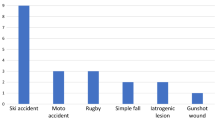Summary
Background. Reports on missile-caused radial nerve injuries are relatively rare in current literature. We present the outcome after repair of such injuries as well as the factors influencing the result of treatment.
Methods. Prospective study included 131 complete missile-caused radial nerve severances repaired with nerve graft or direct suture. Final outcome was defined 4 years postoperatively at least, on the basis of motor recovery (M), EMNG recovery (E) and patient’s judgement on the quality of outcome (P). Recovery was estimated with 0–5 points and final outcome was defined according to the total sum (0–15 points) as: poor, insufficient, good or excellent. Both the good and the excellent outcomes were considered as successful, and both the poor and the insufficient outcome as unsuccessful.
Results. Excellent outcome was noted in 38.2% and good outcome in 47.3% of all patients. Average point score was 9.9 ± 3.3 points for the whole series (domain of good outcome) and 6.6 ± 3.0, 10.1 ± 3.2 and 10.9 ± 2.2 points for high, intermediate and low repairs, respectively (p<0.01). Useful motor recovery (≥M3), good EMNG recovery (≥E3) and affirmative patient’s judgement on the outcome (≥P3) had similar frequencies for intermediate (83.2–89.7%) and low repairs (85.7–92.8%), but for high repairs, good EMNG recovery was more frequent (70%) than were useful motor recovery and affirmative patient’s judgement (40%). Successful outcome was noted in 89.3% of direct sutures and in 82.7% of nerve grafts (p>0.05). Patients with a successful outcome had a significantly shorter nerve defect (p<0.001), shorter preoperative interval (p<0.001) and younger age (p<0.05) than patients with an unsuccessful outcome. Significant deterioration of results began with defects longer than 8 cm, preoperative interval longer than 6 months and age above 40 years.
Conclusions. The outcome is significantly worse after high radial nerve repairs than after intermediate and low repairs. The length of nerve defect, duration of preoperative interval and age of the patient also influence the repair outcome. Correlation of motor recovery with EMNG recovery and with patient’s judgement on the outcome is relatively good, but depends on the level of the repair.
Similar content being viewed by others
Author information
Authors and Affiliations
Rights and permissions
About this article
Cite this article
Roganovic, Z., Petkovic, S. Missile severances of the radial nerve. Results of 131 repairs. Acta Neurochir 146, 1185–1192 (2004). https://doi.org/10.1007/s00701-004-0361-x
Received:
Accepted:
Published:
Issue Date:
DOI: https://doi.org/10.1007/s00701-004-0361-x




